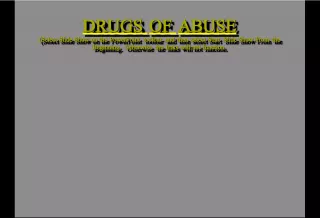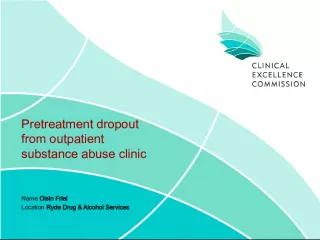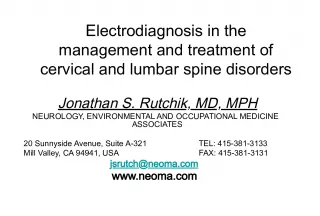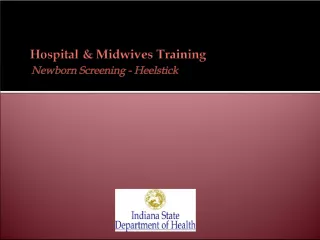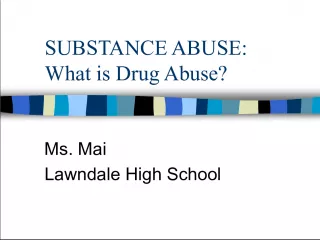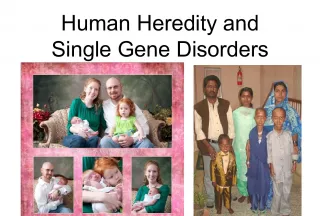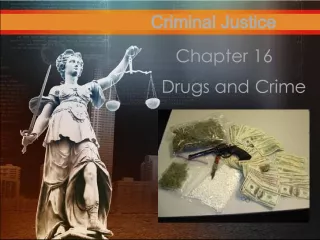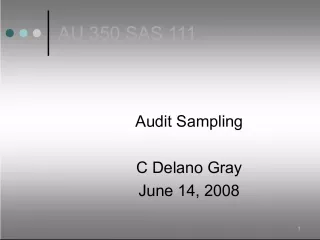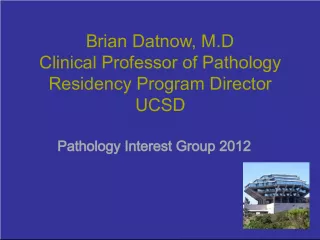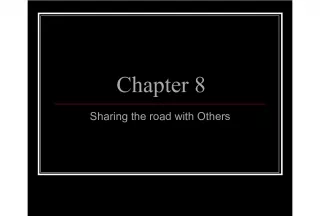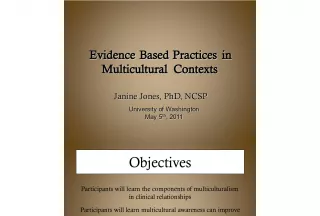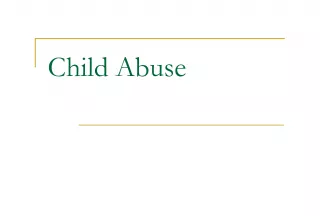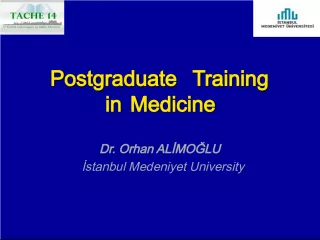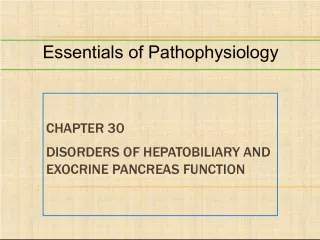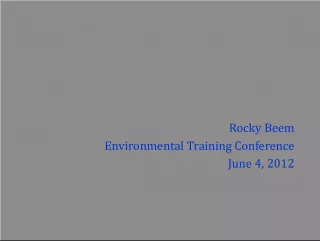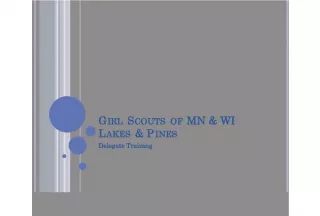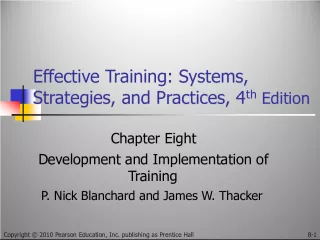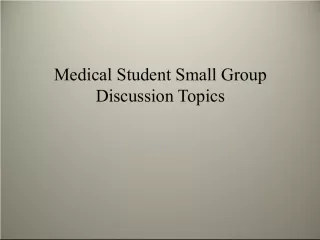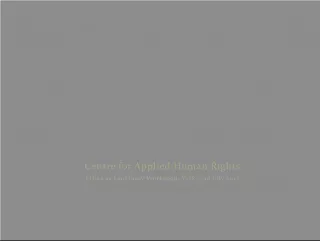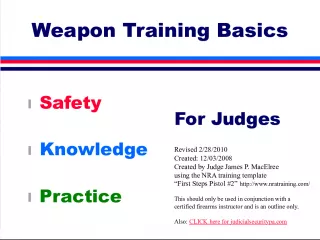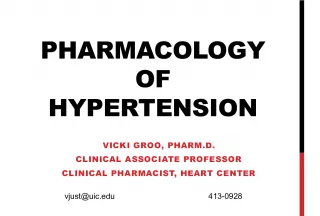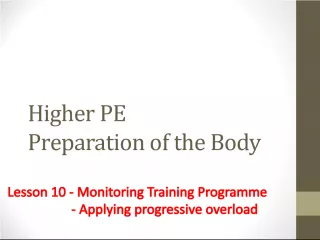Substance Abuse Treatment for Persons with Co-Occurring Disorders Inservice Training Based on TIP 42


This inservice training is designed to provide best practice guidelines for treating substance use disorders in individuals with co-occurring disorders. The training is based on Treatment Improvement Protocol (TIP) 42, which draws on the expertise and knowledge of clinical, research, and administrative experts.
- Uploaded on | 0 Views
-
 trevormoore
trevormoore
About Substance Abuse Treatment for Persons with Co-Occurring Disorders Inservice Training Based on TIP 42
PowerPoint presentation about 'Substance Abuse Treatment for Persons with Co-Occurring Disorders Inservice Training Based on TIP 42'. This presentation describes the topic on This inservice training is designed to provide best practice guidelines for treating substance use disorders in individuals with co-occurring disorders. The training is based on Treatment Improvement Protocol (TIP) 42, which draws on the expertise and knowledge of clinical, research, and administrative experts.. The key topics included in this slideshow are Substance abuse, co-occurring disorders, TIP 42, inservice training, best practice guidelines,. Download this presentation absolutely free.
Presentation Transcript
1. Module 1 Module 1 Substance Abuse Treatment for Persons with Co-Occurring Disorders Inservice Training Based on A Treatment Improvement Protocol TIP 42
2. OH #1-2 TIP 42: Substance Abuse Treatment for Persons with Co-Occurring Disorders Inservice Training What is a TIP? What is a TIP? Best-practice guidelines for treatment of substance use disorders Developed by Center for Substance Abuse Treatment (CSAT) Draws on experience and knowledge of clinical, research, and administrative experts in a particular topic area Consensus Panel for TIP 42, page xi
3. OH #1-3 TIP 42: Substance Abuse Treatment for Persons with Co-Occurring Disorders Inservice Training ATTC Network 2001-2006 ATTC Network 2001-2006 ATTC of New England Northeast ATTC Pacific Southwest ATTC Northwest Frontier ATTC Prairielands ATTC Mid-America ATTC Great Lakes ATTC Gulf Coast ATTC Mountain West ATTC Mid-Atlantic ATTC Southern Coast ATTC Southeast ATTC Central East ATTC Caribbean Basin, Hispanic/Latino & US Virgin Islands ATTC Central East ATTC Northwest Frontier ATTC ATTC National Office
4. OH #1-4 TIP 42: Substance Abuse Treatment for Persons with Co-Occurring Disorders Inservice Training IntroductionModule 1 IntroductionModule 1 The Evolving Field of Co-Occurring Disorders
5. OH #1-5 TIP 42: Substance Abuse Treatment for Persons with Co-Occurring Disorders Inservice Training In This Module . . . In This Module . . . Overview of the evolving field of Co-Occurring Disorders Understanding of the important developments that led to TIP 42 Initial exploration of TIP 42 and how it is organized.
6. OH #1-6 TIP 42: Substance Abuse Treatment for Persons with Co-Occurring Disorders Inservice Training TIP ExerciseTerms TIP ExerciseTerms Read the left column on Page 27 Discuss with your partner: 1. Which of these terms have you ever used or heard? 2. Which of these terms are used in your programs? 3. What advantages does the term co-occurring disorders have over dual diagnosis and dual disorder? Over the other terms?
7. OH #1-7 TIP 42: Substance Abuse Treatment for Persons with Co-Occurring Disorders Inservice Training Co-Occurring Disorders Co-Occurring Disorders Co-occurring disorders Refers to co-occurring substance use (abuse or dependence) and mental disorders. Clients said to have co-occurring disorders have: one or more disorders relating to the use of alcohol and/or other drugs of abuse and one or more mental disorders. Diagnosis of co-occurring disorders (COD) occurs when at least one disorder of each type can be established independent of the other and is not simply a cluster of symptoms resulting from the one disorder.
8. OH #1-8 TIP 42: Substance Abuse Treatment for Persons with Co-Occurring Disorders Inservice Training Co-Occurring Disorders: Your setting Co-Occurring Disorders: Your setting 1. Do these definitions describe clients in your practice/program? (Estimate percentage or describe prevalence) 2. How has serving clients with COD affected your practice/program? 3. What challenges do clients with COD present to your clinical knowledge and skills?
9. OH #1-9 TIP 42: Substance Abuse Treatment for Persons with Co-Occurring Disorders Inservice Training Co-Occurring Disorders: Implications Co-Occurring Disorders: Implications Treatment Prevalence of COD, multiple problems they create, impact on treatment and treatment outcome, new models/strategies are receiving attention and encouraging treatment innovation Clinicians & Knowledge Dissemination Knowledge of both mental health and substance abuse is essential and dissemination of knowledge has become widespread
10. OH #1-10 TIP 42: Substance Abuse Treatment for Persons with Co-Occurring Disorders Inservice Training Why a new TIP on Co-Occurring Disorders? Why a new TIP on Co-Occurring Disorders? Availability of data Treatment innovations for other populations with COD Changes in treatment delivery Advances in treatment Recent developments
11. OH #1-11 TIP 42: Substance Abuse Treatment for Persons with Co-Occurring Disorders Inservice Training Prevalence of COD Prevalence of COD In 2002, 4 million adults met the criteria for both serious mental illness (SMI) and substance dependence and abuse. An estimated 10 million Americans of all ages and in both institutional and non-institutional settings have COD in any given year.
12. OH #1-12 TIP 42: Substance Abuse Treatment for Persons with Co-Occurring Disorders Inservice Training Prevalence of COD among SMI and SA Adult Populations Prevalence of COD among SMI and SA Adult Populations
13. OH #1-13 TIP 42: Substance Abuse Treatment for Persons with Co-Occurring Disorders Inservice Training Prevalence and Other Data Prevalence and Other Data Data now show: COD are common in general adult population. Increased prevalence of people with COD and programs for people with COD. People with COD are more likely to be hospitalized and the rate may be increasing. Rates of mental disorders increase as the number of substance use disorders increase.
14. OH #1-14 TIP 42: Substance Abuse Treatment for Persons with Co-Occurring Disorders Inservice Training Why a new TIP on Co-Occurring Disorders? Why a new TIP on Co-Occurring Disorders? Availability of data Treatment innovations for other populations with COD Changes in treatment delivery Advances in treatment Recent developments
15. OH #1-15 TIP 42: Substance Abuse Treatment for Persons with Co-Occurring Disorders Inservice Training Advances in Treatment of COD Advances in Treatment of COD No wrong door policy Mutual self-help for people with COD Integrated care as a priority for people with severe and persistent mental illness Development of effective approaches, models, and strategies Pharmacological advances
16. OH #1-16 TIP 42: Substance Abuse Treatment for Persons with Co-Occurring Disorders Inservice Training Recent Developments Recent Developments National Registry of Effective Programs and Practices (NREPP) Co-Occurring Disorders State Incentive Grants (COSIG) Co-Occurring Center for Excellence (COCE) Report to Congress on the Prevention and Treatment of Co-Occurring Substance Use Disorders and Mental Disorders Co-Occurring Disorders: Integrated Dual Disorders Treatment Implementation Resource Kit
17. Module 2 Module 2 Introduction Definitions, Terms and Classification Systems for Co-Occurring Disorders
18. OH #1-18 TIP 42: Substance Abuse Treatment for Persons with Co-Occurring Disorders Inservice Training In This Module . . . In This Module . . . Review and discuss terms related to: Substance Use Disorders Mental Disorders Clients Treatment Programs Systems
19. OH #1-19 TIP 42: Substance Abuse Treatment for Persons with Co-Occurring Disorders Inservice Training The Diagnostic and Statistical Manual of Mental Disorders (DSM-IV-TR) The Diagnostic and Statistical Manual of Mental Disorders (DSM-IV-TR) Produced by the American Psychiatric Association (APA). Establishes criteria for diagnosing specific disorders. Used by the medical and mental health fields as a reference for diagnosing substance use and mental health disorders. Provides for a common language for communicating about disorders.
20. OH #1-20 TIP 42: Substance Abuse Treatment for Persons with Co-Occurring Disorders Inservice Training Terms Related to Substance Use Disorders Terms Related to Substance Use Disorders Substance Abuse Substance Dependence addiction
21. OH #1-21 TIP 42: Substance Abuse Treatment for Persons with Co-Occurring Disorders Inservice Training Terms Related to Mental Disorders Personality Disorders Terms Related to Mental Disorders Personality Disorders Cluster A : Involve odd or eccentric behavior. Includes paranoid , schizoid , and schizotypal personality disorders. Cluster B: Involve dramatic, emotional, or erratic behavior. Includes antisocial, borderline, histrionic , and narcissistic personality disorders. Cluster C: Involve anxious, fearful behavior. Includes avoidant, dependent, and obsessive-compulsive personality disorders.
22. OH #1-22 TIP 42: Substance Abuse Treatment for Persons with Co-Occurring Disorders Inservice Training Psychotic Disorders Psychotic Disorders Delusions Hallucinations These clients constitute what is commonly referred to as the serious and persistent mentally ill population Schizophrenia Paranoid type Disorganized type Catatonic type Undifferentiated type Residual type
23. OH #1-23 TIP 42: Substance Abuse Treatment for Persons with Co-Occurring Disorders Inservice Training Mood and Anxiety Disorders Mood and Anxiety Disorders Mood disorders Depression Mania Bipolar disorder Anxiety disorders Social phobia Panic disorders Post traumatic stress disorder (PTSD)
24. OH #1-24 TIP 42: Substance Abuse Treatment for Persons with Co-Occurring Disorders Inservice Training Terms Related to Clients Terms Related to Clients Person-centered terminology Terms for co-occurring disorders Diagnosis vs. symptoms
25. OH #1-25 TIP 42: Substance Abuse Treatment for Persons with Co-Occurring Disorders Inservice Training Terms Related to Treatment Levels of Service Terms Related to Treatment Levels of Service American Society of Addiction Medicine s Patient Placement Criteria Level 0.5 Early Intervention Level I Outpatient Treatment Level II Intensive Outpatient/ Partial Hospitalization Level III Residential/ Inpatient Level IV Medically Managed Intensive Inpatient Treatment
26. OH #1-26 TIP 42: Substance Abuse Treatment for Persons with Co-Occurring Disorders Inservice Training Terms Related to Treatment Quadrants of Care Terms Related to Treatment Quadrants of Care
27. OH #1-27 TIP 42: Substance Abuse Treatment for Persons with Co-Occurring Disorders Inservice Training Terms Related To Treatment Terms Related To Treatment Interventions Integrated Interventions Episodes of Treatment Integrated Treatment Culturally Competent Treatment Integrated Counselor Competencies
28. OH #1-28 TIP 42: Substance Abuse Treatment for Persons with Co-Occurring Disorders Inservice Training Terms Related to Programs Terms Related to Programs Key Programs Mental health-based programs Substance abuse treatment programs Program Types Addiction only services Dual diagnosis capable Dual diagnosis enhanced
29. OH #1-29 TIP 42: Substance Abuse Treatment for Persons with Co-Occurring Disorders Inservice Training Terms Related to Systems Terms Related to Systems Substance Abuse Treatment System Mental Health Services System Interlinking Systems Comprehensive Continuous Integrated System of Care
30. OH #1-30 TIP 42: Substance Abuse Treatment for Persons with Co-Occurring Disorders Inservice Training Discussion Discussion From a client or clinician or system perspective: How does terminology help and hinder service to clients with co-occurring disorders? Which of the terms mentioned are most useful to you? Which do you want to know more about?
31. Module 3A Module 3A Introduction Keys to Successful Programming: Guiding Principles and Core Components
32. OH #1-32 TIP 42: Substance Abuse Treatment for Persons with Co-Occurring Disorders Inservice Training TIP Chapter 3 TIP Chapter 3 Module 3A Guiding principles in treatment Core components in delivery of services Module 3B Improving substance abuse treatment systems and programs Workforce development and staff support
33. OH #1-33 TIP 42: Substance Abuse Treatment for Persons with Co-Occurring Disorders Inservice Training In This Module . . . In This Module . . . Effective Treatment Guiding Principles for effective treatment of clients with COD Effective Delivery Core Components for ideal delivery of services for clients with COD
34. OH #1-34 TIP 42: Substance Abuse Treatment for Persons with Co-Occurring Disorders Inservice Training Delivery of Services Core Components Delivery of Services Core Components Guiding Principles for Effective Treatment Core Components for Effective Delivery of Services Employ a recovery perspective 1 Providing Access Adopt a multi-problem viewpoint 2 Completing a full assessment Develop a phased approach 3 Providing an appropriate level of care Address real-life problems early 4 Achieving integrated treatment Plan for cognitive and functional impairments 5 Providing comprehensive services Use support systems to maintain and extend treatment effectiveness 6 Ensuring continuity of care
35. OH #1-35 TIP 42: Substance Abuse Treatment for Persons with Co-Occurring Disorders Inservice Training TIP ExerciseGuiding Principles & Core Components TIP ExerciseGuiding Principles & Core Components 1. In your own words explain your assigned Guiding Principle. Give examples of how you apply (or need to apply) this principle in your practice or program. 2. In your own words explain your assigned Core Component. Is this an area of strength or challenge for your agency? Explain. (15 minutes)
36. OH #1-36 TIP 42: Substance Abuse Treatment for Persons with Co-Occurring Disorders Inservice Training Quick TIP Exercise Levels of Program Capacity Quick TIP Exercise Levels of Program Capacity With your group 1. Review Figure 3-2 on page 44 and explanatory text on page 43 (left column). 2. Where on the graph would you place your agency? Why? (5 minutes)
37. Module 3B Module 3B Introduction Keys to Successful Programming: Improving Substance Abuse Treatment Systems & Programs and Workforce Development & Staff Support
38. OH #1-38 TIP 42: Substance Abuse Treatment for Persons with Co-Occurring Disorders Inservice Training Delivery of Services Core Components Delivery of Services Core Components Guiding Principles for Effective Treatment Core Components for Effective Delivery of Services Employ a recovery perspective 1 Providing Access Adopt a multi-problem viewpoint 2 Completing a full assessment Develop a phased approach 3 Providing an appropriate level of care Address real-life problems early 4 Achieving integrated treatment Plan for cognitive and functional impairments 5 Providing comprehensive services Use support systems to maintain and extend treatment effectiveness 6 Ensuring continuity of care
39. OH #1-39 TIP 42: Substance Abuse Treatment for Persons with Co-Occurring Disorders Inservice Training TIP Chapter 3 TIP Chapter 3 Module 3A Guiding principles in treatment Core components in delivery of services Module 3B Improving substance abuse treatment systems and programs Workforce development and staff support
40. OH #1-40 TIP 42: Substance Abuse Treatment for Persons with Co-Occurring Disorders Inservice Training Improving Substance Abuse Treatment Systems & Programs Improving Substance Abuse Treatment Systems & Programs Challenges include: How do we organize a system that will provide continuity of care? How do we access funding for program improvement? How do we integrate research and practice to give clients the benefit of proven treatment strategies?
41. OH #1-41 TIP 42: Substance Abuse Treatment for Persons with Co-Occurring Disorders Inservice Training TIP ExerciseAttitudes & Values Self-Assessment TIP ExerciseAttitudes & Values Self-Assessment For each item in Figure 3-7 (p. 57) assess yourself based on your observable behavior, the way you think an outside evaluator would assess you. (3 minutes) + Excels in this area - Needs to work on OK Adequate
42. OH #1-42 TIP 42: Substance Abuse Treatment for Persons with Co-Occurring Disorders Inservice Training TIP ExerciseBasic Competencies Self-Assessment TIP ExerciseBasic Competencies Self-Assessment For each item in Figure 3-8 (p. 58) assess yourself based on your observable behavior, the way you think an outside evaluator would assess you (5 minutes) + Excels in this area - Needs to work on OK Adequate
43. OH #1-43 TIP 42: Substance Abuse Treatment for Persons with Co-Occurring Disorders Inservice Training TIP ExerciseAvoiding Burnout Self-Assessment TIP ExerciseAvoiding Burnout Self-Assessment For each item bulleted on page 62 assess how well you take care of yourself by complying with these recommendations + Excels in this area - Needs to work on OK Adequate (3 minutes) Which two are most difficult?
44. Module 4A Module 4A Introduction Assessment: Screening and Step 1 & Step 2
45. OH #1-45 TIP 42: Substance Abuse Treatment for Persons with Co-Occurring Disorders Inservice Training TIP Chapter 4: Assessment TIP Chapter 4: Assessment Module 4A Introduction, terminology, Step 1Step 2 Module 4B The Assessment Process: Step 3Step 7 Module 4C The Assessment Process: Step 8Step 12 Case studies, review of relevant appendices, and key considerations in treatment matching.
46. OH #1-46 TIP 42: Substance Abuse Treatment for Persons with Co-Occurring Disorders Inservice Training Screening Screening Screening for COD seeks to answer a yes or no question: Does the substance abuse client being screened show signs of a possible mental health problem? OR Does the mental health client being screened show signs of a possible substance abuse problem?
47. OH #1-47 TIP 42: Substance Abuse Treatment for Persons with Co-Occurring Disorders Inservice Training TIP Exercise Screening Instruments TIP Exercise Screening Instruments Option 1: Behavioral Rehearsal & Discussion With your partner, take turns administering whichever instrument is least familiar: Mental Health Screening Form-III (p. 500) Simple Screening Instrument for Substance Abuse (p. 506) You have 10 minutes total!
48. OH #1-48 TIP 42: Substance Abuse Treatment for Persons with Co-Occurring Disorders Inservice Training TIP Exercise Screening Instruments TIP Exercise Screening Instruments Option 2: Review & Discussion Review instruments in: Appendix H (p. 497) and Appendix G (p. 487). Discuss with your partner: Which instruments have you used? What, in your experience, are advantages and disadvantages of each? Which would you recommend? Why? You have 10 minutes total!
49. OH #1-49 TIP 42: Substance Abuse Treatment for Persons with Co-Occurring Disorders Inservice Training Screening Protocol Screening Protocol A professionally designed screening process or protocol establishes precisely . . . How any screening tools or questions are scored What constitutes scoring positive for a particular possible problem (establishing cut-off scores) What happens if a client scores in the positive range and provides the standard forms to document Results of all later assessments That each staff member has carried out his or her responsibilities in the process
50. OH #1-50 TIP 42: Substance Abuse Treatment for Persons with Co-Occurring Disorders Inservice Training Screening+Assessment Tx Plan Screening+Assessment Tx Plan Screening is a process for evaluating the possible presence of a particular problem. Assessment is a process for defining the nature of that problem and developing specific treatment recommendations for addressing the problem. A comprehensive assessment serves as the basis for an individualized treatment plan. The treatment plan must be matched to individual needs.
51. OH #1-51 TIP 42: Substance Abuse Treatment for Persons with Co-Occurring Disorders Inservice Training Step 1: Engage the Client Step 1: Engage the Client No wrong door Empathic detachment Person-centered assessment Sensitivity to culture, gender, and sexual orientation Trauma sensitivity
52. Module 4B Module 4B Introduction Assessment: Step 3Step
53. OH #1-53 TIP 42: Substance Abuse Treatment for Persons with Co-Occurring Disorders Inservice Training TIP Chapter 4: Assessment TIP Chapter 4: Assessment Module 4A Screening and Step 1Step 2 Module 4B The Assessment Process: Step 3Step 7 Module 4C The Assessment Process: Step 8Step 12
54. OH #1-54 TIP 42: Substance Abuse Treatment for Persons with Co-Occurring Disorders Inservice Training 12 Step Assessment Process 12 Step Assessment Process 1: Engage the client 2: Identify & contact collaterals to gather additional information 3: Screen for & detect COD 4: Determine quadrant & locus of responsibility 5: Determine level of care 6: Determine diagnosis 7: Determine disability & functional impairment 8: Identify strengths & supports 9: Identify cultural & linguistic needs & supports 10: Identify problem domains 11: Determine stage of change 12: Plan treatment
55. OH #1-55 TIP 42: Substance Abuse Treatment for Persons with Co-Occurring Disorders Inservice Training Screening Screening Screening for COD seeks to answer a yes or no question: Does the substance abuse client being screened show signs of a possible mental health problem? OR Does the mental health client being screened show signs of a possible substance abuse problem?
56. OH #1-56 TIP 42: Substance Abuse Treatment for Persons with Co-Occurring Disorders Inservice Training Step 3: Screen and Detect COD Step 3: Screen and Detect COD Screen for: Acute safety risk Past and present mental health symptoms/disorders Past and present substance abuse disorders Cognitive and learning deficits Past and present victimization and trauma
57. OH #1-57 TIP 42: Substance Abuse Treatment for Persons with Co-Occurring Disorders Inservice Training Screening for Substance Use Disorder (Mental Health settings) Screening for Substance Use Disorder (Mental Health settings) Substance abuse symptom checklists Substance abuse severity checklists Formal screening tools that work around denial Screening of urine, saliva, or hair samples
58. OH #1-58 TIP 42: Substance Abuse Treatment for Persons with Co-Occurring Disorders Inservice Training 12 Step Assessment Process 12 Step Assessment Process 1: Engage the client 2: Identify & contact collaterals to gather additional information 3: Screen for & detect COD 4: Determine quadrant & locus of responsibility 5: Determine level of care 6: Determine diagnosis 7: Determine disability & functional impairment 8: Identify strengths & supports 9: Identify cultural & linguistic needs & supports 10: Identify problem domains 11: Determine stage of change 12: Plan treatment
59. OH #1-59 TIP 42: Substance Abuse Treatment for Persons with Co-Occurring Disorders Inservice Training Step 4: Determine Quadrant and Locus of Responsibility Step 4: Determine Quadrant and Locus of Responsibility
60. OH #1-60 TIP 42: Substance Abuse Treatment for Persons with Co-Occurring Disorders Inservice Training Determination of SMI Status Determination of SMI Status What is the States criteria for SMI? How is eligibility established? Is the client already receiving mental health priority services? Does the client appear to be eligible?
61. OH #1-61 TIP 42: Substance Abuse Treatment for Persons with Co-Occurring Disorders Inservice Training Step 4: Determine Quadrant and Locus of Responsibility Step 4: Determine Quadrant and Locus of Responsibility
62. OH #1-62 TIP 42: Substance Abuse Treatment for Persons with Co-Occurring Disorders Inservice Training TIP Exercise Cases & Quadrants of Care TIP Exercise Cases & Quadrants of Care With your partner: Select one case (Maria M., or George T., or Jane B.) on pp. 69 and 70. Change or add information that would result in assignment of that case to a different quadrant. (1 minute)
63. OH #1-63 TIP 42: Substance Abuse Treatment for Persons with Co-Occurring Disorders Inservice Training 12 Step Assessment Process 12 Step Assessment Process 1: Engage the client 2: Identify & contact collaterals to gather additional information 3: Screen for & detect COD 4: Determine quadrant & locus of responsibility 5: Determine level of care 6: Determine diagnosis 7: Determine disability & functional impairment 8: Identify strengths & supports 9: Identify cultural & linguistic needs & supports 10: Identify problem domains 11: Determine stage of change 12: Plan treatment
64. OH #1-64 TIP 42: Substance Abuse Treatment for Persons with Co-Occurring Disorders Inservice Training Level of Care Instruments Level of Care Instruments ASAM PPC 2R - Dimensions Acute Intoxication and/or Withdrawal Potential Biomedical Conditions and Complications Emotional, Behavioral, or Cognitive Conditions and Complications (includes risk) Readiness to Change Relapse, Continued Use, or Continued Problem Potential Recovery/Living Environment LOCUS - Dimensions Risk of Harm Functionality Comorbidity (Medical, Addictive, Psychiatric) Recovery Support and Stress Treatment Attitude and Engagement Treatment History
65. OH #1-65 TIP 42: Substance Abuse Treatment for Persons with Co-Occurring Disorders Inservice Training 12 Step Assessment Process 12 Step Assessment Process 1: Engage the client 2: Identify & contact collaterals to gather additional information 3: Screen for & detect COD 4: Determine quadrant & locus of responsibility 5: Determine level of care 6: Determine diagnosis 7: Determine disability & functional impairment 8: Identify strengths & supports 9: Identify cultural & linguistic needs & supports 10: Identify problem domains 11: Determine stage of change 12: Plan treatment
66. OH #1-66 TIP 42: Substance Abuse Treatment for Persons with Co-Occurring Disorders Inservice Training Step 6: Determine Diagnosis Step 6: Determine Diagnosis Principle 1 Diagnosis is established more by history than by current symptom presentation. Principle 2 It is important to document prior diagnoses and gather information related to current diagnoses. Principle 3 It is almost always necessary to tie mental symptoms to specific periods of time in the clients history, in particular times when active substance use disorder was not present.
67. OH #1-67 TIP 42: Substance Abuse Treatment for Persons with Co-Occurring Disorders Inservice Training 12 Step Assessment Process 12 Step Assessment Process 1: Engage the client 2: Identify & contact collaterals to gather additional information 3: Screen for & detect COD 4: Determine quadrant & locus of responsibility 5: Determine level of care 6: Determine diagnosis 7: Determine disability & functional impairment 8: Identify strengths & supports 9: Identify cultural & linguistic needs & supports 10: Identify problem domains 11: Determine stage of change 12: Plan treatment
68. OH #1-68 TIP 42: Substance Abuse Treatment for Persons with Co-Occurring Disorders Inservice Training TIP ExerciseStep 7 Application to Case Examples TIP ExerciseStep 7 Application to Case Examples Review with your partner the case on p. 89 OR the case on p. 90. In your opinion, how useful was the determination of disability and functional impairment: For the counselor? For the client? (3 minutes)
69. OH #1-69 TIP 42: Substance Abuse Treatment for Persons with Co-Occurring Disorders Inservice Training Assessing Functional Capability Assessing Functional Capability Is the client capable of living independently? If not, what types of support are needed? Is the client capable of supporting himself financially? Through what means? If not, is the client disabled or financially dependent on others? Can the client engage in reasonable social relationships? Are there good social supports? If not, what interferes, and what supports are needed? What is the clients level of intelligence? Is there a developmental or learning disability? Cognitive or memory impairments? Limited ability to read, write, or understand? Difficulties focusing and completing tasks?
70. Module 4C Module 4C Introduction Assessment: Step 8Step 12
71. OH #1-71 TIP 42: Substance Abuse Treatment for Persons with Co-Occurring Disorders Inservice Training TIP Chapter 4: Assessment TIP Chapter 4: Assessment Module 4A Screening and Step 1Step 2 Module 4B The Assessment Process: Step 3Step 7 Module 4C The Assessment Process: Step 8Step 12
72. OH #1-72 TIP 42: Substance Abuse Treatment for Persons with Co-Occurring Disorders Inservice Training 12 Step Assessment Process 12 Step Assessment Process 1: Engage the client 2: Identify & contact collaterals to gather additional information 3: Screen for & detect COD 4: Determine quadrant & locus of responsibility 5: Determine level of care 6: Determine diagnosis 7: Determine disability & functional impairment 8: Identify strengths & supports 9: Identify cultural & linguistic needs & supports 10: Identify problem domains 11: Determine stage of change 12: Plan treatment
73. OH #1-73 TIP 42: Substance Abuse Treatment for Persons with Co-Occurring Disorders Inservice Training 12 Step Assessment Process 12 Step Assessment Process 1: Engage the client 2: Identify & contact collaterals to gather additional information 3: Screen for & detect COD 4: Determine quadrant & locus of responsibility 5: Determine level of care 6: Determine diagnosis 7: Determine disability & functional impairment 8: Identify strengths & supports 9: Identify cultural & linguistic needs & supports 10: Identify problem domains 11: Determine stage of change 12: Plan treatment
74. OH #1-74 TIP 42: Substance Abuse Treatment for Persons with Co-Occurring Disorders Inservice Training 12 Step Assessment Process 12 Step Assessment Process 1: Engage the client 2: Identify & contact collaterals to gather additional information 3: Screen for & detect COD 4: Determine quadrant & locus of responsibility 5: Determine level of care 6: Determine diagnosis 7: Determine disability & functional impairment 8: Identify strengths & supports 9: Identify cultural & linguistic needs & supports 10: Identify problem domains 11: Determine stage of change 12: Plan treatment
75. OH #1-75 TIP 42: Substance Abuse Treatment for Persons with Co-Occurring Disorders Inservice Training Cultural AssessmentCOD Cultural AssessmentCOD Three important issues for those with COD: Not fitting into the treatment culture (do not fit into either substance abuse or mental health treatment culture) and conflict in treatment Cultural and linguistic service barriers Problems with literacy
76. OH #1-76 TIP 42: Substance Abuse Treatment for Persons with Co-Occurring Disorders Inservice Training 12 Step Assessment Process 12 Step Assessment Process 1: Engage the client 2: Identify & contact collaterals to gather additional information 3: Screen for & detect COD 4: Determine quadrant & locus of responsibility 5: Determine level of care 6: Determine diagnosis 7: Determine disability & functional impairment 8: Identify strengths & supports 9: Identify cultural & linguistic needs & supports 10: Identify problem domains 11: Determine stage of change 12: Plan treatment
77. OH #1-77 TIP 42: Substance Abuse Treatment for Persons with Co-Occurring Disorders Inservice Training 12 Step Assessment Process 12 Step Assessment Process 1: Engage the client 2: Identify & contact collaterals to gather additional information 3: Screen for & detect COD 4: Determine quadrant & locus of responsibility 5: Determine level of care 6: Determine diagnosis 7: Determine disability & functional impairment 8: Identify strengths & supports 9: Identify cultural & linguistic needs & supports 10: Identify problem domains 11: Determine stage of change 12: Plan treatment
78. OH #1-78 TIP 42: Substance Abuse Treatment for Persons with Co-Occurring Disorders Inservice Training TIP ExerciseStages of Change TIP ExerciseStages of Change (3 minutes) Using the case on p. 94, what stage of readiness to change would you and your partner(s) assign the client regarding her: a) Mental disorder? b) Substance use disorder? c) Give reasons Stages of Change Precontemplation Contemplation Preparation Action Maintenance
79. OH #1-79 TIP 42: Substance Abuse Treatment for Persons with Co-Occurring Disorders Inservice Training 12 Step Assessment Process 12 Step Assessment Process 1: Engage the client 2: Identify & contact collaterals to gather additional information 3: Screen for & detect COD 4: Determine quadrant & locus of responsibility 5: Determine level of care 6: Determine diagnosis 7: Determine disability & functional impairment 8: Identify strengths & supports 9: Identify cultural & linguistic needs & supports 10: Identify problem domains 11: Determine stage of change 12: Plan treatment
80. OH #1-80 TIP 42: Substance Abuse Treatment for Persons with Co-Occurring Disorders Inservice Training TIP ExercisePlan Treatment TIP ExercisePlan Treatment With your group, use format on p. 96 to . . . Plan treatment for: Maria M. (pp. 69, 87, 89, 92) or Jane B. (pp. 70, 83, 91) Address at least two (2) problems Include for each: Related information (strengths, cultural issues, etc.) Stage of readiness to change Recommended interventions Goals (10 minutes)
81. Module 5A Module 5A Introduction Strategies for Working with Clients with Co-Occurring Disorders: Guidelines for a Successful Therapeutic Alliance
82. OH #1-82 TIP 42: Substance Abuse Treatment for Persons with Co-Occurring Disorders Inservice Training 12 Step Assessment Process 12 Step Assessment Process 1. Engage the client 2. Identify & contact collaterals to gather additional information 3. Screen for & detect COD 4. Determine quadrant & locus of responsibility 5. Determine level of care 6. Determine diagnosis 7. Determine disability & functional impairment 8. Identify strengths & supports 9. Identify cultural & linguistic needs & supports 10. Identify problem domains 11. Determine stage of change 12. Plan treatment
83. OH #1-83 TIP 42: Substance Abuse Treatment for Persons with Co-Occurring Disorders Inservice Training In This Module . . . In This Module . . . Module 5A Review guidelines for maintaining a successful therapeutic relationship with a client who has COD Module 5B Examine techniques for working with clients with COD
84. OH #1-84 TIP 42: Substance Abuse Treatment for Persons with Co-Occurring Disorders Inservice Training TIP Exercise Advice to the Counselor TIP Exercise Advice to the Counselor With your partner(s): 1. Imagine you are a person with COD receiving services. 2. Review your assigned Advice to the Counselor text box. 3. Which two (2) recommendations would you most want your provider to follow? Why? (8 minutes)
85. OH #1-85 TIP 42: Substance Abuse Treatment for Persons with Co-Occurring Disorders Inservice Training TIP ExerciseReport Out TIP ExerciseReport Out State the Guideline you examined. Read aloud all of the recommendations. State which two (2) your group chose. Give reasons for your groups choice and summarize any discussion that took place. (2 minutes)
86. OH #1-86 TIP 42: Substance Abuse Treatment for Persons with Co-Occurring Disorders Inservice Training Guidelines for Developing Successful Therapeutic Relationships Guidelines for Developing Successful Therapeutic Relationships 1. Develop and use a therapeutic alliance to engage the client in treatment 2. Maintain a recovery perspective 3. Manage countertransference 4. Monitor psychiatric symptoms 5. Use supportive and empathic counseling 6. Employ culturally appropriate methods 7. Increase structure and support
87. OH #1-87 TIP 42: Substance Abuse Treatment for Persons with Co-Occurring Disorders Inservice Training Guidelines for Developing Successful Therapeutic Relationships Guidelines for Developing Successful Therapeutic Relationships 1. Develop and use a therapeutic alliance to engage the client in treatment 2. Maintain a recovery perspective 3. Manage countertransference 4. Monitor psychiatric symptoms 5. Use supportive and empathic counseling 6. Employ culturally appropriate methods 7. Increase structure and support
88. OH #1-88 TIP 42: Substance Abuse Treatment for Persons with Co-Occurring Disorders Inservice Training Guidelines for Developing Successful Therapeutic Relationships Guidelines for Developing Successful Therapeutic Relationships 1. Develop and use a therapeutic alliance to engage the client in treatment 2. Maintain a recovery perspective 3. Manage countertransference 4. Monitor psychiatric symptoms 5. Use supportive and empathic counseling 6. Employ culturally appropriate methods 7. Increase structure and support
89. OH #1-89 TIP 42: Substance Abuse Treatment for Persons with Co-Occurring Disorders Inservice Training Guidelines for Developing Successful Therapeutic Relationships Guidelines for Developing Successful Therapeutic Relationships 1. Develop and use a therapeutic alliance to engage the client in treatment 2. Maintain a recovery perspective 3. Manage countertransference 4. Monitor psychiatric symptoms 5. Use supportive and empathic counseling 6. Employ culturally appropriate methods 7. Increase structure and support
90. OH #1-90 TIP 42: Substance Abuse Treatment for Persons with Co-Occurring Disorders Inservice Training Potential for Harm Potential for Harm Ask explicitly about suicide or the intention to do harm to someone else when the client assessment indicates that either is an issue. Monitor clients who express such thoughts closely. Ask about suicidal thoughts and plans as a routine part of every session with a suicidal or depressed person. Immediately follow up appointments missed by an acutely suicidal person. Review discussion of suicidality in Chapter 8 and in Appendix D of TIP 42.
91. OH #1-91 TIP 42: Substance Abuse Treatment for Persons with Co-Occurring Disorders Inservice Training Guidelines for Developing Successful Therapeutic Relationships Guidelines for Developing Successful Therapeutic Relationships 1. Develop and use a therapeutic alliance to engage the client in treatment 2. Maintain a recovery perspective 3. Manage countertransference 4. Monitor psychiatric symptoms 5. Use supportive and empathic counseling 6. Employ culturally appropriate methods 7. Increase structure and support
92. OH #1-92 TIP 42: Substance Abuse Treatment for Persons with Co-Occurring Disorders Inservice Training Confrontation Confrontation The heart of confrontation is not the aggressive breaking down of the client and his or her defenses, but feedback on behavior and the compelling appeal to the client for personal honesty, truthfulness in interacting with others, and responsible behavior. TIP 42, p. 110
93. OH #1-93 TIP 42: Substance Abuse Treatment for Persons with Co-Occurring Disorders Inservice Training Guidelines for Developing Successful Therapeutic Relationships Guidelines for Developing Successful Therapeutic Relationships 1. Develop and use a therapeutic alliance to engage the client in treatment 2. Maintain a recovery perspective 3. Manage countertransference 4. Monitor psychiatric symptoms 5. Use supportive and empathic counseling 6. Employ culturally appropriate methods 7. Increase structure and support
94. OH #1-94 TIP 42: Substance Abuse Treatment for Persons with Co-Occurring Disorders Inservice Training Guidelines for Developing Successful Therapeutic Relationships Guidelines for Developing Successful Therapeutic Relationships 1. Develop and use a therapeutic alliance to engage the client in treatment 2. Maintain a recovery perspective 3. Manage countertransference 4. Monitor psychiatric symptoms 5. Use supportive and empathic counseling 6. Employ culturally appropriate methods 7. Increase structure and support
95. Module 5B Module 5B Introduction Strategies for Working with Clients with Co-Occurring Disorders: Techniques for a Working with Clients with COD
96. OH #1-96 TIP 42: Substance Abuse Treatment for Persons with Co-Occurring Disorders Inservice Training In This Module . . . In This Module . . . Module 5A Guidelines for a successful Therapeutic Relationship with a Client who has COD Module 5B Techniques for Working with Clients with CO
97. OH #1-97 TIP 42: Substance Abuse Treatment for Persons with Co-Occurring Disorders Inservice Training Key Techniques for Working With Clients Who Have COD Key Techniques for Working With Clients Who Have COD 1. Motivational enhancement consistent with the clients stage of change. 2. Contingency management techniques to address specific target behaviors. 3. Cognitive-behavioral therapeutic techniques. 4. Relapse prevention techniques. 5. Repetition and skills-building to address deficits in functioning. 6. Facilitate client participation in mutual self-help groups.
98. OH #1-98 TIP 42: Substance Abuse Treatment for Persons with Co-Occurring Disorders Inservice Training Motivational Interviewing (MI) Motivational Interviewing (MI) Motivational Interviewing (MI) is a client-centered, directive method for enhancing intrinsic motivation to change by exploring and resolving ambivalence. Source: Miller and Rollnick 2002, p. 25.
99. OH #1-99 TIP 42: Substance Abuse Treatment for Persons with Co-Occurring Disorders Inservice Training Key Techniques for Working With Clients Who Have COD Key Techniques for Working With Clients Who Have COD 1. Motivational enhancement consistent with the clients stage of change. 2. Contingency management techniques to address specific target behaviors. 3. Cognitive-behavioral therapeutic techniques. 4. Relapse prevention techniques. 5. Repetition and skills-building to address deficits in functioning. 6. Facilitate client participation in mutual self-help groups.
100. OH #1-100 TIP 42: Substance Abuse Treatment for Persons with Co-Occurring Disorders Inservice Training Key Techniques for Working With Clients Who Have COD Key Techniques for Working With Clients Who Have COD 1. Motivational enhancement consistent with the clients stage of change. 2. Contingency management techniques to address specific target behaviors. 3. Cognitive-behavioral therapeutic techniques. 4. Relapse prevention techniques. 5. Repetition and skills-building to address deficits in functioning. 6. Facilitate client participation in mutual self-help groups.
101. OH #1-101 TIP 42: Substance Abuse Treatment for Persons with Co-Occurring Disorders Inservice Training Key Techniques for Working With Clients Who Have COD Key Techniques for Working With Clients Who Have COD 1. Motivational enhancement consistent with the clients stage of change. 2. Contingency management techniques to address specific target behaviors. 3. Cognitive-behavioral therapeutic techniques. 4. Relapse prevention techniques. 5. Repetition and skills-building to address deficits in functioning. 6. Facilitate client participation in mutual self-help groups.
102. OH #1-102 TIP 42: Substance Abuse Treatment for Persons with Co-Occurring Disorders Inservice Training Relapse Prevention Relapse Prevention . . . a central element of all clinical approaches to relapse prevention is anticipating problems that are likely to arise in maintaining change and labeling them as high-risk situations for resumed substance use, then helping clients to develop effective strategies to cope with those high-risk situations without having a lapse. TIP 42, p. 128
103. OH #1-103 TIP 42: Substance Abuse Treatment for Persons with Co-Occurring Disorders Inservice Training Key Techniques for Working With Clients Who Have COD Key Techniques for Working With Clients Who Have COD 1. Motivational enhancement consistent with the clients stage of change. 2. Contingency management techniques to address specific target behaviors. 3. Cognitive-behavioral therapeutic techniques. 4. Relapse prevention techniques. 5. Repetition and skills-building to address deficits in functioning. 6. Facilitate client participation in mutual self-help groups.
104. OH #1-104 TIP 42: Substance Abuse Treatment for Persons with Co-Occurring Disorders Inservice Training Key Techniques for Working With Clients Who Have COD Key Techniques for Working With Clients Who Have COD 1. Motivational enhancement consistent with the clients stage of change. 2. Contingency management techniques to address specific target behaviors. 3. Cognitive-behavioral therapeutic techniques. 4. Relapse prevention techniques. 5. Repetition and skills-building to address deficits in functioning. 6. Facilitate client participation in mutual self-help groups.
105. Module 6A Module 6A Introduction Traditional Settings and Models: Essential Programming for Clients with COD
106. OH #1-106 TIP 42: Substance Abuse Treatment for Persons with Co-Occurring Disorders Inservice Training Review 5B Techniques Working with Clients Who Have COD Review 5B Techniques Working with Clients Who Have COD Motivational enhancement Contingency management Cognitive-behavioral techniques Relapse prevention techniques Repetition and skills- building Client participation in mutual self-help groups
107. OH #1-107 TIP 42: Substance Abuse Treatment for Persons with Co-Occurring Disorders Inservice Training In This Module . . . In This Module . . . Module 6A Essential Programming & General Considerations for Treatment of Clients with COD Module 6B Outpatient Substance Abuse Treatment Programs for Clients with COD Module 6C Residential Substance Abuse Treatment Programs for Clients with COD
108. OH #1-108 TIP 42: Substance Abuse Treatment for Persons with Co-Occurring Disorders Inservice Training Discussion Modifications to Group Work Discussion Modifications to Group Work With your partner or small group discuss: What 3 modifications would you advise a novice counselor to make when conducting group therapy with clients with COD? (2 minutes)
109. OH #1-109 TIP 42: Substance Abuse Treatment for Persons with Co-Occurring Disorders Inservice Training Modifications to Group Modifications to Group Reduced intensity Stronger direction Co-leaders Shorter duration Regular schedules Smaller groups Varied participation Brief, simple, concrete, repetitive Emphasis on affirmation
110. OH #1-110 TIP 42: Substance Abuse Treatment for Persons with Co-Occurring Disorders Inservice Training Quick TIP Exercise 7 Recommendations Quick TIP Exercise 7 Recommendations With your group: Rank-order the seven (7) recommendations in order of importance. Be prepared to give your reasons. (2 minutes) 1. Screening, assessment, & referral for persons with COD 2. Physical & mental health consultation 3. Prescribing onsite psychiatrist 4. Medication & medication monitoring 5. Psychoeducational classes 6. Double trouble groups (onsite) 7. Dual recovery self-help groups (offsite)
111. OH #1-111 TIP 42: Substance Abuse Treatment for Persons with Co-Occurring Disorders Inservice Training DiscussionList Revision DiscussionList Revision With your partner or group 1. Renumber your groups list of seven (7) recommendations in order of importance (if you wish to change the order). 2. Are there any essential program elements you would add? (2 minutes)
112. OH #1-112 TIP 42: Substance Abuse Treatment for Persons with Co-Occurring Disorders Inservice Training DiscussionList Revision Option for Administrators DiscussionList Revision Option for Administrators With your partner or group 1. Renumber your groups list of seven (7) recommendations in order of importance (if you wish to change). 2. Does your program reflect these seven (7) recommendations? In this order? (2 minutes)
113. Module 6B Module 6B Introduction Traditional Settings and Models: Outpatient Substance Abuse Treatment Programs for Clients with COD
114. OH #1-114 TIP 42: Substance Abuse Treatment for Persons with Co-Occurring Disorders Inservice Training Chapter 6 Modules Chapter 6 Modules Module 6A Essential Programming & General Considerations for Treatment of Clients with COD Module 6B Outpatient Substance Abuse Treatment Programs for Clients with COD Module 6C Residential Substance Abuse Treatment Programs for Clients with COD
115. OH #1-115 TIP 42: Substance Abuse Treatment for Persons with Co-Occurring Disorders Inservice Training 7 Essential Elements & General Considerations 7 Essential Elements & General Considerations Working in groups Involving clients in treatment and program design Family education 1. Screening, assessment, & referral for persons with COD 2. Physical & mental health consultation 3. Prescribing onsite psychiatrist 4. Medication & medication monitoring 5. Psychoeducational classes 6. Double trouble groups (onsite) 7. Dual recovery self-help groups (offsite)
116. OH #1-116 TIP 42: Substance Abuse Treatment for Persons with Co-Occurring Disorders Inservice Training In This Module . . . In This Module . . . Outpatient Substance Abuse Treatment Programs for Clients with COD Designing Implementing Evaluating Sustaining Examples of programs
117. OH #1-117 TIP 42: Substance Abuse Treatment for Persons with Co-Occurring Disorders Inservice Training Designing Outpatient Programs for Clients with COD Designing Outpatient Programs for Clients with COD Screening and assessment Centralized intake Reassessment Referral and Placement Engagement Discharge Planning Continuing Care
118. OH #1-118 TIP 42: Substance Abuse Treatment for Persons with Co-Occurring Disorders Inservice Training Quick TIP Exercise Quick TIP Exercise Review Improving Adherence of Clients with COD in Outpatient Settings (p. 147). (3 minutes) 1. Which have been used in your agency? 2. In your experience, what has been most successful in improving engagement in treatment for clients with COD?
119. OH #1-119 TIP 42: Substance Abuse Treatment for Persons with Co-Occurring Disorders Inservice Training Discharge Planning Discharge Planning Housing Case management services Medication management Relapse prevention Positive peer networks Mutual self help groups Advocacy involvement
120. OH #1-120 TIP 42: Substance Abuse Treatment for Persons with Co-Occurring Disorders Inservice Training Continuing Care Continuing Care Clients with COD often require long-term continuity of care that: Supports their progress Monitors their condition Responds to a return to substance use or return to symptoms of mental disorder Describes steps for when & how to reconnect with services
121. OH #1-121 TIP 42: Substance Abuse Treatment for Persons with Co-Occurring Disorders Inservice Training Evaluating Outpatient Programs for Clients with COD Evaluating Outpatient Programs for Clients with COD 1. Define operational goals in terms of the client behaviors 2. Decide on study clients and sampling 3. Locate and/or develop instruments 4. Develop plan for data collection 5. Develop plan for analysis and reporting
122. OH #1-122 TIP 42: Substance Abuse Treatment for Persons with Co-Occurring Disorders Inservice Training Nine Essential Features of ACT Nine Essential Features of ACT 1. Services provided in the community 2. Assertive engagement with active outreach 3. High intensity of services 4. Small caseloads 5. Continuous 24-hour responsibility 6. Team approach 7. Multidisciplinary team, reflecting integration of services 8. Close work with support systems 9. Continuity of staffing Source: Drake et al. 1998a.
123. OH #1-123 TIP 42: Substance Abuse Treatment for Persons with Co-Occurring Disorders Inservice Training ICM Activities and Interventions ICM Activities and Interventions Engage client to facilitate process & connect with community-based treatment programs Assess needs, identify barriers & facilitate access to treatment Offer practical assistance & facilitate linkages Make referrals Advocate for client Monitor progress Provide counseling & support Crisis intervention Assist in facilitating communication between service providers
124. OH #1-124 TIP 42: Substance Abuse Treatment for Persons with Co-Occurring Disorders Inservice Training TIP ExerciseAct / ICM Grid TIP ExerciseAct / ICM Grid In small groups, use the information in your TIP text to complete the handout grid for the model you have been assigned (ACT or ICM). (5 minutes)
125. Module 6C Module 6C Introduction Traditional Settings and Models: Residential Substance Abuse Treatment Programs for Clients with COD
126. OH #1-126 TIP 42: Substance Abuse Treatment for Persons with Co-Occurring Disorders Inservice Training Chapter 6 Modules Chapter 6 Modules Module 6A Essential Programming & General Considerations for Treatment of Clients with COD Module 6B Outpatient Substance Abuse Treatment Programs for Clients with COD Module 6C Residential Substance Abuse Treatment Programs for Clients with COD
127. OH #1-127 TIP 42: Substance Abuse Treatment for Persons with Co-Occurring Disorders Inservice Training 7 Essential Elements & General Considerations 7 Essential Elements & General Considerations Working in groups Involving clients in treatment and program design Family education 1. Screening, assessment, & referral for persons with COD 2. Physical & mental health consultation 3. Prescribing onsite psychiatrist 4. Medication & medication monitoring 5. Psychoeducational classes 6. Double trouble groups (onsite) 7. Dual recovery self-help groups (offsite)
128. OH #1-128 TIP 42: Substance Abuse Treatment for Persons with Co-Occurring Disorders Inservice Training In This Module . . . In This Module . . . Residential Substance Abuse Treatment for Clients with COD Designing Implementing Evaluating Sustaining Examples of programs
129. OH #1-129 TIP 42: Substance Abuse Treatment for Persons with Co-Occurring Disorders Inservice Training Designing Residential Programs for Clients with COD Designing Residential Programs for Clients with COD Intake Assessment Engagement Continuing Care Discharge Planning
130. OH #1-130 TIP 42: Substance Abuse Treatment for Persons with Co-Occurring Disorders Inservice Training TIP ExerciseDesign TIP ExerciseDesign In groups or with partners: 1. Read recommendations on your topic. 2. Think about how these activities are conducted in your programs. 3. Describe what could stay the same and what would need to change in your program to meet the recommendations for COD programs. (8 minutes)
131. OH #1-131 TIP 42: Substance Abuse Treatment for Persons with Co-Occurring Disorders Inservice Training Intake Steps Intake Steps 1. Written referral 2. Intake interview 3. Program review 4. Team meeting
132. OH #1-132 TIP 42: Substance Abuse Treatment for Persons with Co-Occurring Disorders Inservice Training Assessment Areas Assessment Areas Substance abuse evaluation Mental health evaluation Health and medical evaluation Entitlements Client status
133. OH #1-133 TIP 42: Substance Abuse Treatment for Persons with Co-Occurring Disorders Inservice Training Continuing Care Continuing Care Goals: sustaining abstinence continuing recovery community living vocational skills gainful employment deeper understanding increase responsibility family difficulties consolidating changes Key Services: life skills education relapse prevention 12-Step or double trouble groups case management (especially for housing) vocational training and employment
134. OH #1-134 TIP 42: Substance Abuse Treatment for Persons with Co-Occurring Disorders Inservice Training Discharge Planning Discharge Planning Housing Case management services Medication management Relapse prevention Positive peer networks Mutual self help groups Advocacy involvement
135. OH #1-135 TIP 42: Substance Abuse Treatment for Persons with Co-Occurring Disorders Inservice Training Staffing Recommendations Staffing Recommendations Program director Secretary Program supervisor 10 line staff Clinical coordinator Nurse practitioner (half-time) Entitlements counselor (half-time) Vocational rehabilitation counselor (half-time) Consultive arrangements for medical, psychiatric, and psychological input or care
136. OH #1-136 TIP 42: Substance Abuse Treatment for Persons with Co-Occurring Disorders Inservice Training Quick TIP ExerciseTraining Quick TIP ExerciseTraining 1. With your partner, look over the questions in Figure 6-3 (pp. 167168). 2. Substitute the treatment model used in your workplace for each TC in the questions. 3. Which questions can you answer easily? 4. Which are you less sure of? (2 minutes)
137. OH #1-137 TIP 42: Substance Abuse Treatment for Persons with Co-Occurring Disorders Inservice Training Evaluating Residential Programs for Clients with COD Evaluating Residential Programs for Clients with COD 1. Define operational goals in terms of the client behaviors 2. Decide on study clients and sampling 3. Locate and/or develop instruments 4. Develop plan for data collection 5. Develop plan for analysis and reporting
138. OH #1-138 TIP 42: Substance Abuse Treatment for Persons with Co-Occurring Disorders Inservice Training Sustaining Residential Programs for Clients with COD Sustaining Residential Programs for Clients with COD For quality control, the CQI staff uses: Observation Key informant interviews Resident focus groups Standardized instruments Staff review
139. OH #1-139 TIP 42: Substance Abuse Treatment for Persons with Co-Occurring Disorders Inservice Training Therapeutic Community (TC) Therapeutic Community (TC) Goals: Promote abstinence Decrease antisocial behavior Effect a global change in lifestyle, including attitudes and values View: Drug abuse is a disorder of the whole person, reflecting problems in conduct, attitudes, moods, values, and emotional management The community is the healing agent
140. Module 7A Module 7A Introduction Special Settings and Specific Populations: Acute Care and Other Medical Settings, and Dual Recovery Mutual Self-Help Groups
141. OH #1-141 TIP 42: Substance Abuse Treatment for Persons with Co-Occurring Disorders Inservice Training Chapter 6 Modules Chapter 6 Modules Module 6A Essential Programming & General Considerations for Treatment of Clients with COD Module 6B Outpatient Substance Abuse Treatment Programs for Clients with COD Module 6C Residential Substance Abuse Treatment Programs for Clients with COD
142. OH #1-142 TIP 42: Substance Abuse Treatment for Persons with Co-Occurring Disorders Inservice Training In This Module . . . In This Module . . . Module 7A Acute care and other medical settings Dual recovery and mutual self help programs Module 7B Specific populations with COD: homeless, criminal justice, women
143. OH #1-143 TIP 42: Substance Abuse Treatment for Persons with Co-Occurring Disorders Inservice Training TIP Resources TIP Resources TIP 16 Alcohol and Other Drug Screening of Hospitalized Trauma Patients TIP 19 Detoxification from Alcohol and Other Drugs TIP 24 A Guide for Substance Abuse Services for Primary Care Physicians TIP 34 Brief Interventions and Brief Therapies for Substance Abuse
144. OH #1-144 TIP 42: Substance Abuse Treatment for Persons with Co-Occurring Disorders Inservice Training TIP ExerciseDual Recovery TIP ExerciseDual Recovery In groups review your assigned topic, then answer: 1. Is this topic ever an issue for COD clients in your agency? 2. If any participate in 12-Step groups, what has been their experience with this issue? 3. What could be done to address this issue in your agency? In your community? (10 minutes)
145. Module 7B Module 7B Introduction Special Settings and Specific Populations: Homeless, Criminal Justice, Women
146. OH #1-146 TIP 42: Substance Abuse Treatment for Persons with Co-Occurring Disorders Inservice Training In This Module . . . In This Module . . . Module 7A Acute care and other medical settings Dual recovery and mutual self help programs Module 7B Specific populations with COD: homeless, criminal justice, women
147. OH #1-147 TIP 42: Substance Abuse Treatment for Persons with Co-Occurring Disorders Inservice Training TIP Resources TIP Resources TIP 17 Planning for Alcohol and Other Drug Abuse Treatment for Adults in the Criminal Justice System TIP 21 Combining Alcohol and Other Drug Abuse Treatment With Diversion for Juveniles in the Justice System TIP 30 Continuity of Offender Treatment for Substance Use Disorders From Institution to Community Upcoming TIPs Substance Abuse Treatment for Adults in the Criminal Justice System Substance Abuse Treatment: Addressing the Specific Needs of Women http://www.treatment.org/
148. OH #1-148 TIP 42: Substance Abuse Treatment for Persons with Co-Occurring Disorders Inservice Training TIP ExercisePopulation Jigsaw TIP ExercisePopulation Jigsaw 1. Read about your assigned population and answer handout questions. 2. Regroup so there is a 1, 2, 3, and 4 in your small group. 3. Take turns teaching each other what youve learned. 4. Report out on groups discussion. (3 minutes each) (10 minutes)
149. Module 8A Module 8A Introduction A Brief Overview of Specific Mental Disorders and Cross-Cutting Issues: Suicidality, Nicotine Dependence, and Personality Disorders
150. OH #1-150 TIP 42: Substance Abuse Treatment for Persons with Co-Occurring Disorders Inservice Training Module 7 Module 7 Module 7A Acute care and other medical settings Dual recovery and mutual self help programs Module 7B Specific populations with COD: homeless, criminal justice, women
151. OH #1-151 TIP 42: Substance Abuse Treatment for Persons with Co-Occurring Disorders Inservice Training Chapters Format Chapters Format Disorder category (i.e. Personality, Mood, Anxiety, Psychotic) What counselors should know about this category and substance abuse Specific disorders within each category What counselors should know about substance abuse and the specific disorder Diagnostic features and criteria from the DSM-IV-TR Case study Advice to the counselor
152. OH #1-152 TIP 42: Substance Abuse Treatment for Persons with Co-Occurring Disorders Inservice Training In This Module . . . In This Module . . . Module 8A Cross-Cutting Issues: Suicidality, Nicotine Dependence Personality Disorders Module 8B Mood and Anxiety Disorders Schizophrenia and Other Psychotic Disorders Module 8C Attention Deficit/Hyperactivity Disorder (AD/HD) Posttraumatic Stress Disorder (PTSD) Eating Disorders Pathological Gambling Appendix D
153. OH #1-153 TIP 42: Substance Abuse Treatment for Persons with Co-Occurring Disorders Inservice Training TIP Exercise Group Assignments TIP Exercise Group Assignments Group 1Suicidality (pp. 214216) Appendix D, pp. 326333 Group 2Nicotine Dependence (pp. 216220) Appendix D, pp. 333347 Group 3Borderline Personality (pp. 220224) Appendix D, pp. 353359 Group 4Antisocial Personality (pp. 224226) Appendix D, pp. 359368 (15 minutes)
154. OH #1-154 TIP 42: Substance Abuse Treatment for Persons with Co-Occurring Disorders Inservice Training TIP Exercise TIP Exercise What Counselors Should Know, Diagnostic Features & Criteria, Advice to the Counselor, & Case Study With your group: Read the text section on your assigned diagnosis. Answer the handout questions. Prepare to teach the larger group. (15 minutes)
155. Module 8B Module 8B Introduction A Brief Overview of Specific Mental Disorders and Cross-Cutting Issues: Mood & Anxiety Disorders, Schizophrenia & Other Psychotic Disorders
156. OH #1-156 TIP 42: Substance Abuse Treatment for Persons with Co-Occurring Disorders Inservice Training Chapters Format Chapters Format Disorder category (i.e. Personality, Mood, Anxiety, Psychotic) What counselors should know about this category and substance abuse Specific disorders within each category What counselors should know about substance abuse and the specific disorder Diagnostic features and criteria from the DSM-IV-TR Case study Advice to the counselor
157. OH #1-157 TIP 42: Substance Abuse Treatment for Persons with Co-Occurring Disorders Inservice Training In This Module . . . In This Module . . . Module 8A Cross-Cutting Issues: Suicidality, Nicotine Dependence Personality Disorders Module 8B Mood and Anxiety Disorders Schizophrenia and Other Psychotic Disorders Module 8C Attention Deficit/Hyperactivity Disorder (AD/HD) Posttraumatic Stress Disorder (PTSD) Eating Disorders Pathological Gambling Appendix D
158. OH #1-158 TIP 42: Substance Abuse Treatment for Persons with Co-Occurring Disorders Inservice Training TIP ExerciseAssignments TIP ExerciseAssignments Group 1Mood Disorder Diagnosis pp. 227228 Discussion pp. 226230; and 369383 Group 2Anxiety Disorder Diagnosis p. 230 Discussion pages same as Mood Disorder Group 3Schizophrenia Discussion pp. 231235; and 385400
159. OH #1-159 TIP 42: Substance Abuse Treatment for Persons with Co-Occurring Disorders Inservice Training TIP ExerciseRole Play TIP ExerciseRole Play With your group: Review the texts sections on your assigned diagnosis and related information. Create a 35 minute role-play script that illustrates key information. A scene likely to play out in your practice All group members must have a role Teach us by performing your role play. (20 minutes)
160. Module 8C Module 8C Introduction A Brief Overview of Specific Mental Disorders and Cross-Cutting Issues: ADHD, PTSD, Eating Disorders, Pathological Gambling
161. OH #1-161 TIP 42: Substance Abuse Treatment for Persons with Co-Occurring Disorders Inservice Training In This Module . . . In This Module . . . Module 8A Cross-Cutting Issues: Suicidality, Nicotine Dependence Personality Disorders Module 8B Mood and Anxiety Disorders Schizophrenia and Other Psychotic Disorders Module 8C Attention Deficit/Hyperactivity Disorder (AD/HD) Posttraumatic Stress Disorder (PTSD) Eating Disorders Pathological Gambling Appendix D
162. OH #1-162 TIP 42: Substance Abuse Treatment for Persons with Co-Occurring Disorders Inservice Training TIP ExerciseAssignments TIP ExerciseAssignments Group 1AD/HD (pp. 235237) Appendix D, pp. 402408 Group 2PTSD (pp. 238240) Appendix D, pp. 408416 Group 3Eating Disorders (pp. 240246) Appendix D, pp. 417425 Group 4Pathological Gambling (pp. 246248) Appendix D, pp. 425436
163. OH #1-163 TIP 42: Substance Abuse Treatment for Persons with Co-Occurring Disorders Inservice Training TIP Exercise Panel Presentation TIP Exercise Panel Presentation With your group: Review the texts sections on your assigned diagnosis and related information. Create a 3 5 minute panel presentation on: How to Recognize and Work with Substance Abuse Clients Who Also Have ______ Disorder Features to look for Prevalence, assessment, and engagement Practical information on working with client (18 minutes)
164. Module 9 Module 9 Introduction Substance-Induced Disorders
165. OH #1-165 TIP 42: Substance Abuse Treatment for Persons with Co-Occurring Disorders Inservice Training Module 8A Cross-Cutting Issues: Suicidality, Nicotine Dependence Personality Disorders Module 8B Mood and Anxiety Disorders Schizophrenia and Other Psychotic Disorders Chapter 8 Chapter 8 Module 8C Attention Deficit/Hyperactivity Disorder (AD/HD) Posttraumatic Stress Disorder (PTSD) Eating Disorders Pathological Gambling Appendix D
166. OH #1-166 TIP 42: Substance Abuse Treatment for Persons with Co-Occurring Disorders Inservice Training What Every Counselor Should Know What Every Counselor Should Know Types of medications: Antipsychotics Antimanic Antidepressants Antianxiety Stimulants Narcotics Antiparkinsonian Hypnotics Addiction treatment Free download at www.mattc.org
167. OH #1-167 TIP 42: Substance Abuse Treatment for Persons with Co-Occurring Disorders Inservice Training In This Module . . . In This Module . . . Substance-Induced Disorders Description Alcohol Caffeine Cocaine and Amphetamines Hallucinogens Nicotine Opioids Sedatives Diagnostic Considerations Case Studies Appendix F
168. OH #1-168 TIP 42: Substance Abuse Treatment for Persons with Co-Occurring Disorders Inservice Training TIP Exercise Substance-Induced Disorders TIP Exercise Substance-Induced Disorders With your group: Review the texts sections on the assigned substance. Use your handout to create a brief case study. (15 minutes)
